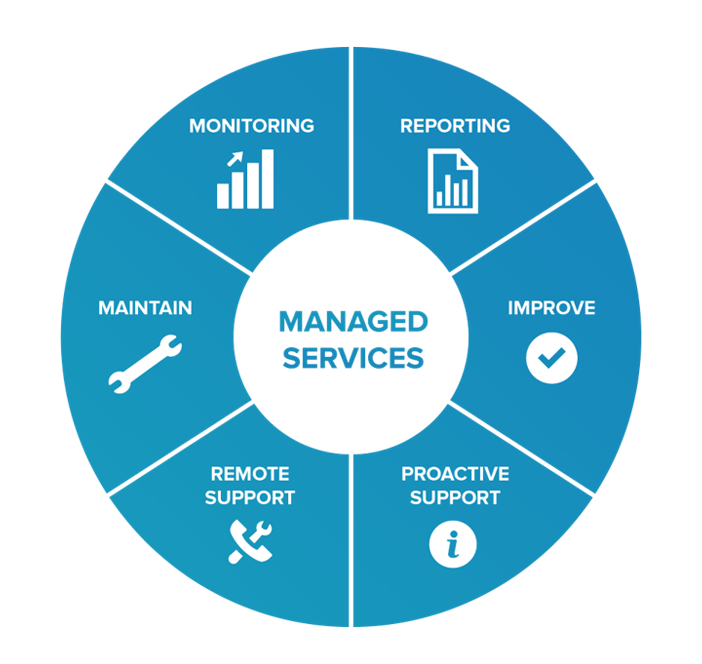Remote IT infrastructure monitoring
A common category of managed IT service is the remote management and administration of servers, workstations, and mobile devices. Remote management and monitoring is often essential, core service for a supplier of managed services. And, because several MSPs offer this service, competition is intense, and profit margins have been under pressure. This has led to new and more specialized types of managed IT services, like the ones we will discuss next.
Security services
The productization of and monitoring-led managed services have prompted MSPs to refine their service catalogs. One prevalent route is managed security services. Customers increasingly expect their service providers to provide assistance with IT systems and data security. In response, service providers are establishing managed security services strategies or forming partnerships with security companies to deliver 100% outsourced cybersecurity solutions.
Managed end-user services
End-user services may include a vast range of solutions, but they often center around the IT assistance channels and processes that an organization has established for its workers and customers.
End-user services include, at the most fundamental level, an IT help desk or service desk solution wherein users may resolve technical difficulties with a team of skilled agents. Issues might include assistance for operating systems and portable devices, application installations and upgrades, connectivity issues, and other help desk support IT services. Here, the enterprise hires the managed IT service provider, but its employees and customers directly benefit from a better user experience.
On-site IT services
Often known as managed field services, on-site IT services involve an MSP assigning experts to a designated area to carry out a range of IT activities. This may include equipment installation or maintenance, cabling or wireless installations, site assessments, and much more. Here, the provider is accountable for scheduling and deploying technicians, maintaining issue logs and service requests, and providing post-task communications.
Cloud services
With the introduction of cloud technology, managed IT services have expanded to also include cloud services. MSPs may, for instance, specialize in infrastructure as a service (IaaS), offering managed public cloud services in collaboration with cloud providers like Amazon Web Services (AWS), Google, and Microsoft. Managed IT services can also encompass the implementation and management of the cloud – for example, consulting, assessments, migrations, and more.
Project-based managed IT services
Project-specific technology support is yet another category of managed IT service. This may include solution expertise, such as a major SharePoint build or Salesforce implementation, technology evaluation, or continuing technical assistance for business applications.
If a company lacks the ability or capacity to complete a crucial IT project, it might benefit from collaborating with a managed service provider for administrative assistance and technical experience. In addition, a competent MSP will possess a defined framework and also be able to provide a project schedule and budget breakdown to guarantee that the job is completed as per budgetary and scheduling parameters.
Communication services
Increasingly, enterprise communication comes under the ambit of IT, and you may choose to outsource the administration of communication systems by using managed IT services. Managed communications (sometimes known as unified communications) consolidate telephonic, multimedia, and data communication networks into a single, unified hub.
This implies that employees may access all types of communication the company provides — by simply connecting to a single network rather than requiring separate login credentials for email, video conferencing, and other facilities. Ensuring uptime, encrypting messages, securing video calls, and managing Voice over Internet Protocol (VoIP) licenses are some of the key tasks of MSPs who provide this type of managed IT service.
Analytics services
Managed data analytics services assist in the gathering, assessment, and protection of user and customer data. This might include monitoring site traffic or social networking participation, recognizing trends, and predicting how to enhance outcomes. The MSP is able to transform raw data into insights that are simple to comprehend and ready for use in business decision-making.
You can opt for an all-in-one managed IT service for enterprise-wide business intelligence. Or there are specialized providers for people analytics, market analytics, financial performance analytics, and so on. This type of managed IT service can also be project-based.
Managed print services (MPS)
Managed print services enable the service provider to remotely monitor hardware and offer support, updates, upkeep, and repair. If you have considerable printing demands, such as needing hard copy paperwork or having a big team that needs printer access, this service might be an excellent alternative to consider.
This type of managed IT service will mandatorily cover needs evaluation, hardware replacement, maintenance, and supplies necessary to run new and recent hardware. It could also entail monitoring and reviewing printing activities to identify expenditures that can be minimized if they were avoided. Optionally, MPS providers like HP assist in digital transformation projects like hybrid work enablement or migration to paperless.
Managed backup
Data backup may be bundled with other managed services (such as network, security, and cloud computing), but some service providers offer an additional, comprehensive solution as a standalone option. This may include backing up data on the cloud or even on other servers, developing a disaster recovery blueprint for lost data, and retrieving and restoring data. MSPs may assist with identifying your backup requirements, suggesting how often backups should be conducted, and recommending the scope and extent of the recovery program

